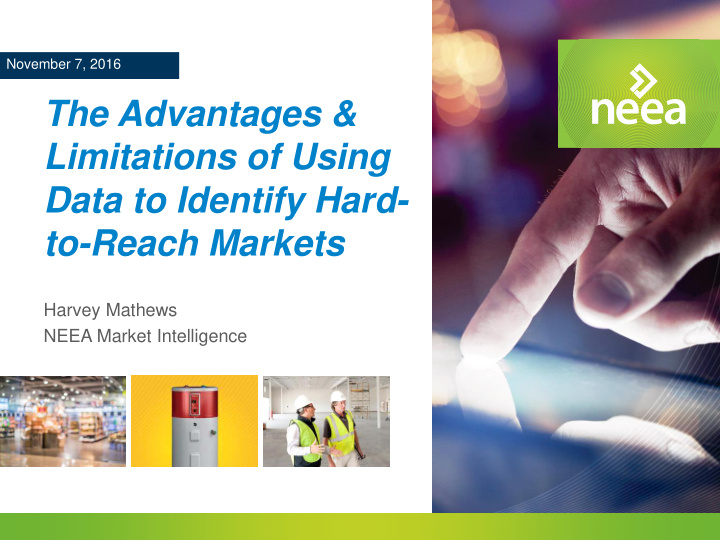



November 7, 2016 The Advantages & Limitations of Using Data to Identify Hard- to-Reach Markets Harvey Mathews NEEA Market Intelligence
Overview − Can be defined using data − Can be identified using data − Can be understood better using data However, data alone won’t improve our ability to break into HTR segments…. 2
Today’s topics 1. What is the HTR market, according to available data? 2. Why are they hard-to-reach? 3. What should we do to leverage data to improve program participation? 3
Types of data needed for current HTR analysis Program Population Energy usage Building stock participation studies data • Address • Commercial • Census • Annual energy Building Stock use • Trade area • Demographic Analysis (Experian) • Bill payment • Sales data (CBSA) program • ‘Firmographic’ • Residential participation (Dunn & Building Stock Bradstreet) Analysis • Psychographic (RBSA) (Experian) • Real property information (Core Logic) 4
Types of tools needed for this analysis − Data blending (Alteryx and R) − Geospatial plotting (Alteryx and ESRI) − Data visualization & exploration (Tableau) − Curious minds 5
Defining HTR with data We can build a composite picture of the HTR with: 1. Program participation analysis 2. Identifying billing:income ratios 3. Geolocation of intended program participants 4. Other indicators that flag a lack of participation 6
1. Program participation − With our current data sources & tools, we just need one piece of program data to gain some analytical insight • Address, geolocation, building type, or demographic info for residential HTR • NAICS code, building stock type, address, or geolocation for commercial/industrial HTR − Compare participants to the rest of population to identify unaddressed groups 7
2. Energy cost-to-income analysis By establishing a median energy bill amount and analyzing it relative to household income, a defacto identification of individual HTR homes can be identified. ACEEE April 2016 study: ‘Lifting the High Energy Burdens in America’s Largest Cities’ • Many low income households spend 2-3x more income on utility bills • Older housing with poor ventilation and aging, inefficient appliances and heating systems are a major factor 8
3. Geolocation If program participation is dependent on retail or trade ally availability, identify HTR through geoanalysis 9
4. Program non-participation flags Indicators of a lack of program involvement may include: − Late bill payment − Low income assistance with bills − Reports from social services that identify health issues known to be related to poorly heated or cooled homes (asthma, respiratory problems, heart disease, arthritis, rheumatism) 10
These four data-enabled approaches build a composite picture of HTR… 1. Participation 2. Income:Bill % 3. Geolocation 4. Other Flags 11
…but there is a bigger picture 12
Why are they hard-to-reach? − If we assume that the HTR are acting in their own best interest with the information they have, then the source of our problem likely is our communication and program design − Are we connecting energy efficient program participation to what they value? 13
The reasons for unequal program participation are complex According to the 2016 World Social Science Report, there are seven drivers of inequality in the world: − Economic − Social − Cultural − Political − Spatial − Environmental − Knowledge Decoding the impact of these drivers on program participation is key to more equitable program involvement 14
In summary… − Newly compiled data & tools can enable us to build a composite picture of the HTR market − However, the reasons for a lack of program participation can only be partially understood with current data − A deeper appreciation of our audience’s current (complex) HTR drivers will likely improve program participation 15
Leveraging regional data to improve program participation
Recommend
More recommend